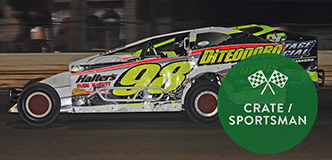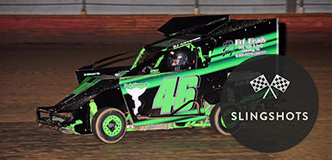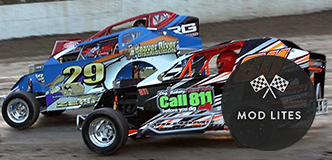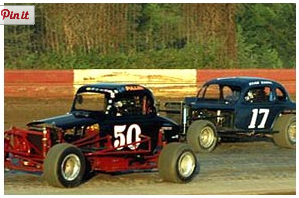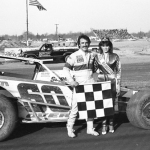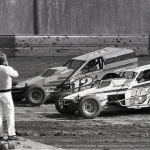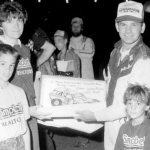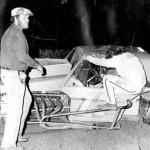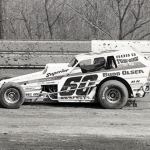
STAY CONNECTED:
Want to know if we’re cancelled?
Want to know what’s going on?
Parking
Parking at the Speedway is free of charge for most shows(there are a few exceptions). Parking for the Monster Truck Throwdown show is $5 per car. Handicap Parking spaces exist on the front rows of the main parking lot and in the pit area for participants. These spaces, like most public parking areas, are for handicap individuals ONLY and are available on a first-come, first served basis.
Access to these areas requires a certified handicap placard that is displayed prominently on the vehicle for inspection, and must be assigned to one of the occupants of the vehicle being parked.
Once all marked spaces have been filled, handicap patrons will be allowed to park anywhere within the VIP parking area in space available. Security personnel assigned to monitor marked handicap parking areas will be issuing city citations to those found in violation.
Camping
The Bridgeport Speedway has camping spaces available. They can be reserved by clicking the link below and filling out the form or by contacting the speedway office at (856) 467- 4407.
Credit Cards
Visa, Mastercard, and Discover are accepted at the Front Gate Ticket windows. The concession stand and Pit Gates are cash only. There is also an ATM machine on site as well by the Front Gate ticket booth.
Rain Policy
In the event of rain or other conditions, it may be necessary for the management to adjust the order of the event schedule, length of races, practices and qualifying races, or to stop the program completely. Should this occur, the management shall make every effort to resume the schedule in a timely fashion if conditions improve. It is their sole discretion as to what decision they make and their decision is final.
Cancellation or delay of an event will be the speedway management’s decision. NO MONEY WILL BE REFUNDED for tickets or pit passes purchased. The armband with the appropriate color shall be used as the rain check. In the event that an event is cancelled, rain checks will only be honored if ALL qualifying races for all divisions have not been completed. All races completed will be scratched and will not be re-scheduled.
Rain Checks will be honored for the next three (3) weeks of equal or lesser value. If the rain check is used for an event of greater value, then the holder will be responsible for making up the difference in value. If the event is rained out or cancelled after one feature race for any division that has been completed, then the remaining feature events will be run at a later date. This date will probably be the next race event scheduled and the make-up features will be first on the program (before any qualifying heats scheduled for the regular event). Only cars qualified for the cancelled event will be eligible for the make-up feature. RAIN CHECKS WILL NOT BE ISSUED FOR EVENTS WHEN THE MAKE-UP FEATURES ARE HELD.
If all qualifying events, including time trials (not consi’s), have been completed, rain checks will NOT be honored. There will be NO CASH REFUNDS in any case.
Once all heats have been completed - shall constitute a complete race in the event a race is stopped due to bad weather. If a race is stopped by use of the red flag and is ruled complete (no matter how many laps are complete), the finishing positions will be paid according to the last officially scored lap by the leader prior to the red flag.
THE Monster Truck Throwdown show in September is the only exception in this case. That show is strictly a RAIN or SHINE show.
Divisions
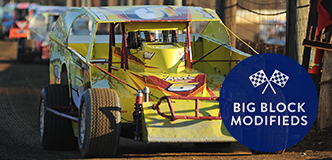
The mighty modifieds with 467 cubic inch motors serve as Bridgeport Speedway’s headline class. If you love the “Big Blocks,” Bridgeport Speedway is the only track in New Jersey to feature them on a weekly basis. These cars run on the ⅝ mile track on Saturday nights weekly.
Drivers in this highly competitive division can use a 358 cubic inch engine with a 2 barrel carb or a 350-400 block crate engine(Ford or GM) to motor around the clay oval. This class fits the pocketbook of all weekly racers and many advance into the Big Block Modified division. These cars run on the ⅝ mile track on Saturday nights weekly.
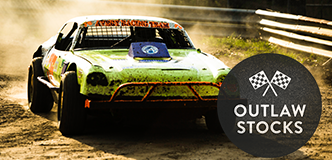 A full bodied stock car that represents the late models of yesterday. Most of these chassis are from 80’s model cars such as Monte Carlos and Camaros that dominated the race tracks of the 1970’s. Don’t be fooled, these guys can fly, and some of the tracks most experienced and seasoned drivers buckle in to do battle each week in the Outlaw Stock division. These cars run on the ⅝ mile track on Saturday nights weekly.
A full bodied stock car that represents the late models of yesterday. Most of these chassis are from 80’s model cars such as Monte Carlos and Camaros that dominated the race tracks of the 1970’s. Don’t be fooled, these guys can fly, and some of the tracks most experienced and seasoned drivers buckle in to do battle each week in the Outlaw Stock division. These cars run on the ⅝ mile track on Saturday nights weekly.
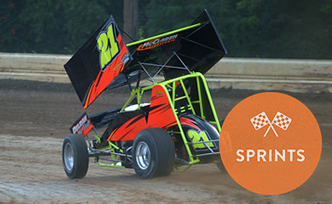 Sprint cars spend most of their time scrambling for traction, broad sliding around corners, wheelstanding on the straight aways, and throwing clay into the stands while the driver wrestles frantically with the steering wheel as he reaches speeds upwards of 140 mph. 900 horsepower is commonplace for these machines which typically have a 410, 360, or 305 cubic inch engines all fueled by methanol. These cars run on the ⅝ mile track on different dates throughout the season.
Sprint cars spend most of their time scrambling for traction, broad sliding around corners, wheelstanding on the straight aways, and throwing clay into the stands while the driver wrestles frantically with the steering wheel as he reaches speeds upwards of 140 mph. 900 horsepower is commonplace for these machines which typically have a 410, 360, or 305 cubic inch engines all fueled by methanol. These cars run on the ⅝ mile track on different dates throughout the season.
Also Featuring:


History of Dirt Modified
The modified stock car is auto racing’s oldest organized form. When stock car racing replaced midgets as America’s most popular short track racing following World War II, it was the Modifieds which were the essence of the sport.
The first major stock car racing sanctioning body was the National Association for Stock Car Auto Racing. And when NASCAR started business in 1948, it sanctioned only one class of cars: Modifieds. The sportsman, Grand National (now Winston Cup) and late model divisions all came later.
In this early era, the word “modified” was a reference to engine specifications. Modified racers were allowed to modify their motors by boring cylinder walls and using oversized pistons. This was contrasted by the sportsman car which had basically a stock engine. Because of the boring, modified motors had a larger cubic inch displacement than their sportsman counterparts. Although both classes of car have evolved dramatically from their WWII infancy, the names modified and sportsman still remain with us in racing today. And the names are still symbolic of the 1940s stockers; meaning a modified is generally a powerful race car and a sportsman type is a smaller engine race car.
A typical 1940/50s modified was generally a stock automobile, with glass removed, a rollcage installed, and a souped up motor. Hence the division’s name: Modified Stock Car.
However in the 1960s, changes in the divison became visibly apparent as the bodies were channeled and lowered. The car builders started mixing and matching components (i.e. a GM frame with a Ford body). A very subtle but historically siginificant alteration also became obvious: front fenders, which were heretofore trimmed for tire clearance, were removed altogether. The changes further made for a lower, leaner racing machine.
But the visual changes of the 1960s were no comparison to the wholesale revolution which altered the modified breed in the 1970s. The customary dirt-track modified stock car circa 1968 featured a 1955 Chevy frame with a 1948 Ford truck front axle, a 1936 Chevy coupe body, 1960 Buick brakes, and a 427 c.i. Corvette engine. Every car component (except the engine) was an item readily available in the neighborhood junkyard. Despite representing a mish-mash of manufacturers, the late 1960s style modified was truly a stock car, made up of stock parts sold by Ford, GM, and Mopar.
But then, seemingly in a rapid fire succession, a trio of revolutions forever altered the face and name of modified stock car racing.
The first change involved the bodies. By the mid-1960s the coupes and sedan shells from the pre-war era were becoming both scarce and expensive. The junkyard man knew if the racer didn’t want to pay the asking price, the antique car collector would make up the difference. Thus, several racers experimented with alternatives to the traditional exterior scheme, using compact bodies like Chevy Corvairs, Ford Falcons and Mustangs. But even these compacts emerged slightly too big and had to be cut to fit properly.
It wasn’t until 1970, when Detroit introduced the sub-compact car, that a solution was discovered. Chevy unveiled the Vega, AMC offered the Gremlin and Ford introduced the Pinto. Late in the same year New Englander Bob Judkins discovered that a Pinto shell fit perfectly over a modified chassis. The first shot in the revolution was sounded.
The body of choice on the dirt circuit was the Gremlin and AMC Eagle. Cars like the Gremlin, Eagle and Dodge’s Omni were very boxy types, with flat sides, flat doors and a flat roof. So crude and simple was the Gremlin body that racers soon found that they could reproduce the Gremlin-look in their shops using flat sheet metal. By the late 1970s homemade bodies were state-of-the-art creations on the DIRT home front.
The late Dick Tobias from Pennsylvania revolutionized the chassis of the modified stock car class in the early 1970s. He began mass production of an entirely homemade chassis of which the roll cage was an integral part, constructed of tubular steel. Tobias also fabricated front axles and other assorted necessary components which were affixed to the generic chassis.
With the Tobias tube chassis, the racer could then have a frame and roll cage of brand new steel as opposed to something that had been sitting in a junkpile for 25 years for not much more in cash outlay and for a significant savings in man hours. DIRT Motorsports proxy Glenn Donnelly legalized the tube chassis at his tracks in 1976.
The third revolution, that of the vital components and essential parts, took place more slowly. In the 1950s drag racing was a very popular sport in America, more so perhaps than oval track racing. And while drag racers were known as big spenders, stock car racers were anything but.
To serve the drag racer many small companies sprung up in the 1950s and 1960s with the sole purpose of producing racing parts; i.e. seats, shocks brakes, wheels, rear ends, roll cage padding, etc. Whatever the item, a team could buy it specially made for competition on the drag strip.
But by 1970, drag racing had lost some of its luster. Interest was waning and the companies that served drag acers with after-market parts began to lose money. To salvage these same companies, the specialty-market producers started to court the oval track fraternity. And by the end of the decade, they had successfully conquered the sport.
“Back in my day I was a champion because I could build a better car,” once moaned 1950s modified kingpin Kenny Shoemaker of Albany. “Now all you have to do is open your wallet and buy a better car.” Indeed, the typical DIRT Modified that evolved from the 1970s was a store-bought custom piece, from front to rear bumper. From a form of car that just a dozen years earlier was made up of 100% junkyard stock parts, the 1980s open-wheel edition consisted of no stock components whatsoever. Therefore, modern-day cars are simply called DIRT Modifieds; not modified stock cars anymore.
The 1980s were a time period filled with vast changes in the outer veneer of the modified the body but little other changes beneath the skin. Floridian Gary Balough placed the final nail in the coffin which contained the word “stock” in the classification of modified stock car. Balough’s 1980 ride the infamous black no. 112 ‘Batmobile’ entry at Syracuse during Super DIRT Week proved to the modified world that what the car’s body did was more important than its actual appearance. So concerted was the notion of “substance over form” in the Balough/Weld mount, what became lost was the idea of what these cars were supposed to look like. So what if street cars don’t have roofs which look like wings! So what if the doors on the family buggy don’t have ground effects! So while the 1980s witnessed various expansions on the thoughts first espoused by Balough and Weld over a decade earlier, the 1990s began and continued with a reversion in the other direction. Only time will tell what the new millennium has in store as today the entire DIRT circuit has assumed an identity all its own. The future remains to determine the destiny of the cars’ outward appearance while the internal components remain essentially the same.
So then just what is a DIRT Modified? Its a five-word question with a fifty-year answer!


